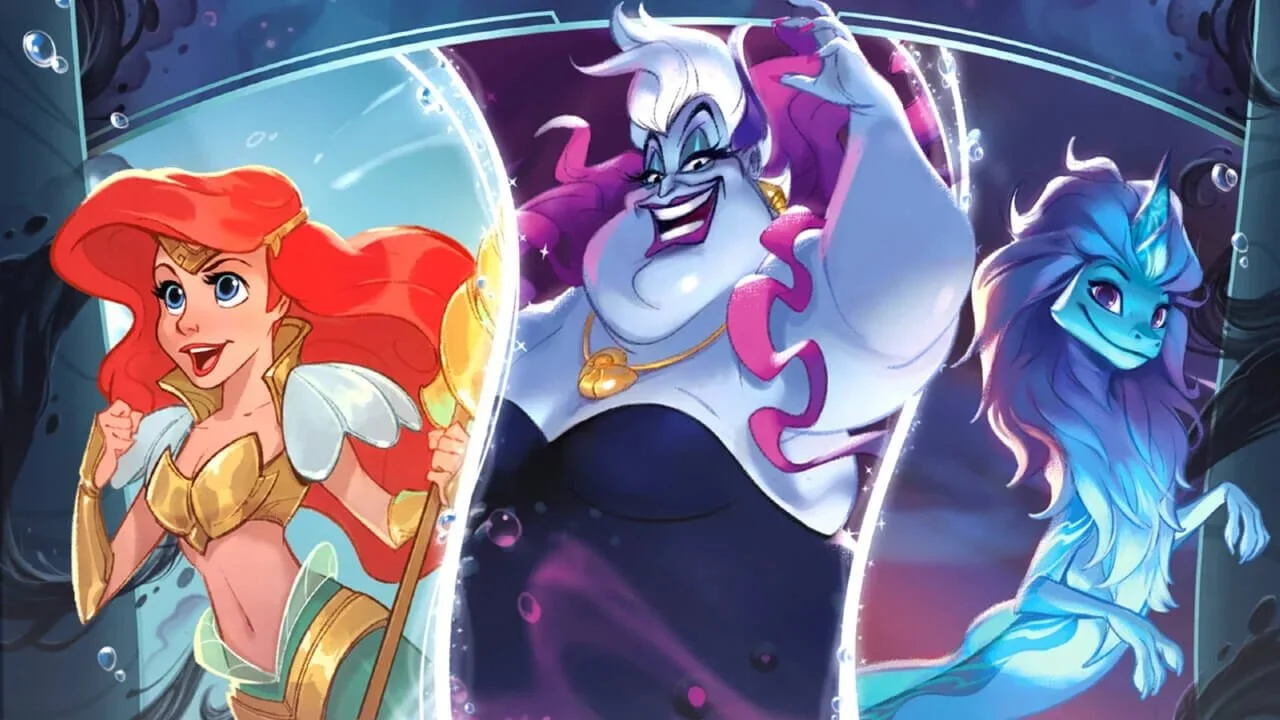Ursula’s Return Marks a Turning Point for Lorcana
I’ve been closely watching and covering the Lorcana game news, gameplay and excitement since just a little after its initial set review. Since then, the game has changed A LOT.
From starting out as a Sapphire/Steel player Shifting Aurora – Dreaming Guardian to sing into Grab Your Sword or A Whole New World by route to using Morph to shift into any Emerald character and…still sing A Whole New World, I feel like I’ve seen it all and it’s only really been a few months.
Unlike writing about other TCGs (I write about Pokemon), writing about Lorcana has brought with it its own fair share of challenges. Where do you get good tournament information? How do you quickly find out what decks are best? Where do you even buy products, and where do you play?
The game has evolved so much that many of the original issues with it are no longer issues. They’re memories. The game isn’t in shortage anymore (packs stick around for days at my local Target) and opportunties to play are ample.
All of this is a good thing. It’s so good, that it makes a set like Ursula’s Return somewhat stand out.
The hardest thing about writing about Lorcana: change
The very hardest thing that covering Lorcana has brought with it form the start was how vastly the game changed with each passing set. Entire strategies were overhauled each time a new set came out.
What decks will be playable? Do I need to buy a new deck every single set? But Lorcana sets are expensive. Are there any budget options?
Why this was hard for me was partly because of how different it is from other TCGs. I’ll use Pokemon as an example because that’s the TCG I know the best. When writing about Pokemon (especially during the pandemic when rotation was delayed) things don’t change all that much very often. There are certain cataclysmic shifts that do cause the game to change but those are few and far between.
For the most part, Pokemon expansions don’t change the game much. In them are usually one or two new deck archetypes that are playable, and maybe a few cards enter the lineup of other decks.
But overall the meta stays the same and the changes are not across the board. In Ursula’ Return, Disney Lorcana is starting to feel more stable like other TCGs.
Suddenly, Lorcana’s meta has stabalized
Up until recently, claims that there really was a Lorcana metagame have been somewhat unsubstantiated. Meta decks changed on a weekly basis, and new powerful decks popped up all the time.
Each new set brought a massive rotation to what was good and what wasn’t good – what was playable and what was casual.
Ursula’s Return marks an important turning point for the game, however. And here’s why.
Ursula’s Return is an upgrade set
Seeing Ursula’s Return come so closely on the heals of a set like Into the Inklands is rather remarkable. Kind of like driving on a freeway at 90 MPH and hitting the breaks to avoid a near accident is remarkable. You feel the jolt.
Up until now, the game has been developing at such a frenetic pace that there hasn’t been a real reason to hit the breaks.
Now, I feel like I’m hitting the breaks hard.
I’ve spent time pouring over deck lists of course, building my own decks, and the strangest thing might just be how playable decks are that don’t even use the new strategies in Ursula’s Return.
You can play Sapphire/Amethyst, for example, without adding in Ariel – Treasure Collector. You could play Emerald/Steel Discard without Diablo if you wanted to. And it would still be viable.
Indeed, most if not all of the decks from last set will largely exist next week the way they did last set – with a few undeniably big upgrades.
To me, this is a beautiful thing.
It had to happen
Massive reshuffles in deck strategies and meta decks were necessary for a fledgling game but ultimately they were not meant to last. The pool of cards to choose from is now nearly 1000 deep, meaning that a bucket-sized splash in a growingly deep pool doesn’t have nearly the impact it once did.
Already we are seeing signs of Lorcana maturing. Whereas Into the Inklands invariably altered the game through the introduction of Locations, Ursula’s Return offers unique cards ideal for specific scenarios and upgrades to strategies we already know without altering the core of the game.
Even new mechanics like Sing Together or altered Shifting come off as relatively niche – not blanket solutions for all decks.
Ursula’s Return is a set we should all be excited about. It marks a turning point in Lorcana’s maturity as a game, shows how the gameplay is becoming rapidly more established, and also will come as a positive to those who already like the decks they’ve been playing and hope to only have to spend a little bit of money upgrading them for set four.

